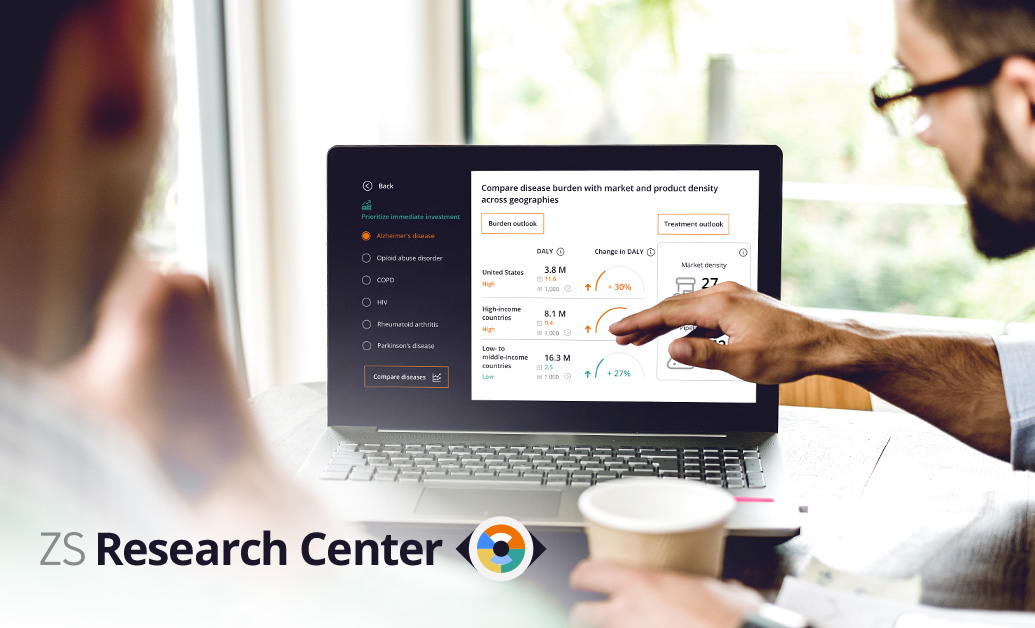In 2022, the ZS Research Center identified a clear and pressing need to examine global disease burden alongside pharma investment in several representative diseases to determine whether current treatments are proportional to the burden experienced by patients and their caregivers. What we and others have found is alarming. When we looked at disease burden and investment side by side, we observed that pharma is overinvesting in some high-burden diseases, in higher-income countries, at the expense of high-burden diseases in middle- to lower-income countries.
While high-burden diseases in middle- to lower-income countries represent 40% of global burden, there are only an average of 52 potential drugs being studied in the pipeline for those diseases. Conversely, high-burden diseases in higher-income countries represent 23% of global disease burden but have an average of 160 drugs in the pipeline. This misalignment represents a three-fold increase in investment to treat half as much disease burden. Diseases like respiratory infections and malaria remain burdensome across middle- to lower-income countries, especially if they lack better medications to treat them.
Existing data about disease burden and investment is incomplete
Around the world, governments and other organizations including the World Health Organization (WHO) closely track global disease burden to help ensure that health system resources are aligned to deliver care to the populations with the greatest needs. Similarly, there are databases, patient organizations, pharma companies and other stakeholders devoted to tracking R&D investment and marketed product density at the disease level, which helps researchers and investors determine which diseases are underpenetrated. There are, however, fewer organizations looking at global disease burden alongside investment to determine whether pipelines and marketed products are aligned with unmet needs globally. In fact, the WHO data on disease burden only represents about 45% of diseases listed in a representative investment database, which means 55% of pharma investment is unaccounted for by disease burden.
There’s a global mismatch between pharma investment and disease burden
While pipeline investment is relatively similar across disease burden in the middle- to lower-income countries, high-burden diseases in higher-income countries have four times as many drugs in the pipeline as low-burden diseases, which are often higher burden in lower- and middle-income countries. This may not be surprising—high-burden diseases should be considered for prioritization when options are few or existing options are less effective or safe. But it also highlights the role a country’s geography and wealth play in determining pharma investment. We must ask ourselves, should this be the case? Our efforts to treat diseases are far from equitable.
While investment in new therapies can often help reduce disease burden in the long run, healthcare stakeholders should also consider access, affordability and health equity as desirable investment opportunities to overcome global disease burden disparities.
How to use the global disease burden and pipeline investment tool
In the tool below we feature data on six conditions—Alzheimer’s disease, opioid abuse disorder, HIV, COPD, rheumatoid arthritis and Parkinson’s disease—that demonstrate some of the misalignment ZS observed in our analysis. In addition to providing an overview of each disease area, you can interact with the tool to see how these conditions compare to each other in terms of global disease burden, the change in disease burden over the last decade and the number of therapies for each—both on the market and in the pipeline.
We classified each disease into one of four categories based on their burden and current global pipeline investment. Those four categories include:
- Prioritize improved access. These are diseases where life sciences companies and other healthcare stakeholders, including regulators, health authorities, health systems, payers and others need to work immediately and more effectively at getting existing therapies into the hands of patients or seek effective alternative options, such as providing netting to prevent the spread of malaria.
- Prioritize immediate investment. These include diseases that carry significant global burden, but have relatively limited treatments—or treatments that are less efficacious or safe. Often, these are diseases of lower- and middle-income countries that do not garner priority investment, which worsens global health inequities.
- Areas of overinvestment. Diseases in this category often have effective, safe and plentiful options on the market. Timely access to medication, especially affordability and availability, are crucial to maintain low disease burden. Only significant leaps in innovation should be prioritized for these diseases.
- Prioritize future investment. Diseases in this quadrant should be tracked in case disease burden starts to increase. Orphan diseases, where data is available, often fall in this bucket, given limited patient populations. In those cases, healthcare stakeholders need to balance overall burden with individual patient burden.
Methodology
For this analysis, ZS used the WHO’s disease-adjusted life years (DALY) data for all countries and geographic groups, for 2000, 2010 and 2019, as well as pipeline investment data for the WHO diseases, from the Pharmaprojects database. We determined geographic and income groups based on the World Bank’s income group categories.
To learn more about our disease burden research and pharma investment, reach out to the ZS Research Center: researchcenter@zs.com
















